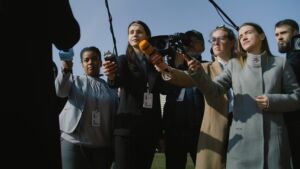The importance of staying “in the message box” during crisis communications was ably demonstrated this week by National Transportation Safety Board (NTSB) chairperson Jennifer Homendy. She ran a textbook press conference in Baltimore shortly after the Francis Scott Key Bridge tanker collision and collapse.
Unlike a typical media interview, which should include elements of storytelling, the “message box” is a tactic used during a crisis interview to stick closely to a tight set of messages. When there is little information to divulge, the message box strategy provides a set of known facts, conveys transparency, and helps the interviewee avoid saying “no comment.”
In her opening statement to reporters, Homendy stayed within the message box by:
- focusing on current known facts, and
- describing the investigation parameters, which include human performance, safety engineering, and securing the recorder data.
During the Q&A, she effectively bridged back to the message box and refused to speculate on questions surrounding the accident cause, safety concerns, and other circulating rumors. She also directed reporters to the NTSB website for live updates. All of this helps disseminate an accurate flow of information and expands reputational trust.
The NTSB has a reputation as a trusted agency for accident investigations. It also has a well-developed strategy for crisis communications. It drills and practices for what and how it can communicate during a crisis. Other organizations can study the NTSB’s approach, and adapt it for their crisis communications playbooks. Learn more:
CSPAN’s Coverage of the NTSB’s Press Conference on March 26th, 2024
From NPR: What we know and don’t know about Baltimore’s Key Bridge collapse
CommCore Can Help Before, During, and After a Crisis
From cyberattacks to automotive safety, from ethical lapses in the C-suite to social media gaffes, no organization is immune from modern crises, and their crippling effects on operations and reputations.
We believe crisis communications planning is an investment; not an expense.
- Studies indicate that every dollar spent on crisis communications planning is worth $7 in losses averted.
- A report by Hotwire suggests that 45% of senior communications executives do not have a crisis communications plan.
- 80% said they were worried that a crisis event would someday affect their organization.
As a leading crisis communications firm, for almost 40 years CommCore has helped organizations be ready — prepared prior to a crisis — and working side-by-side both during and after a crisis to communicate the right message at the right time.
We partner with our clients to ensure they are properly prepared before, supported during and help them protect brands and reputations after a crisis.
Contact our Crisis Communications Trainers & Consultants
We are available and can put you in touch with the right person to help with your specific crisis communications challenge.
To schedule a PressureTest™ Demo or get answers quickly, call us at (202) 659-4177 or email info@CommCoreConsulting.com to contact our crisis communications firm today.


